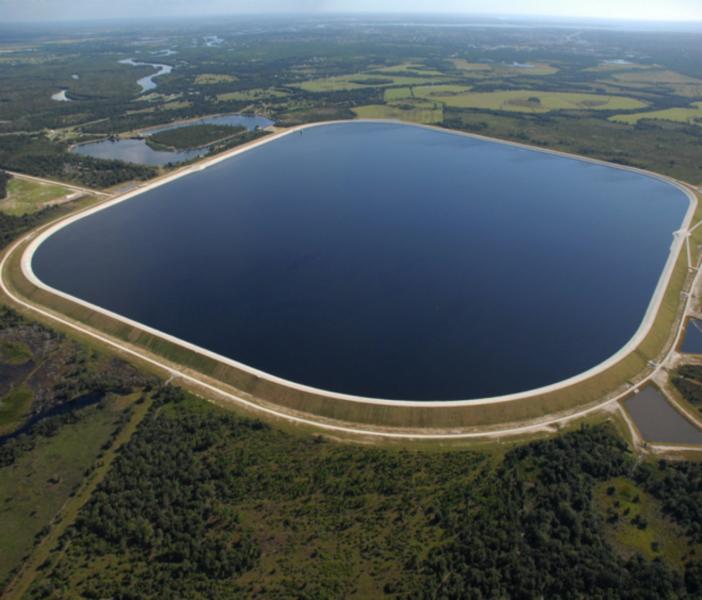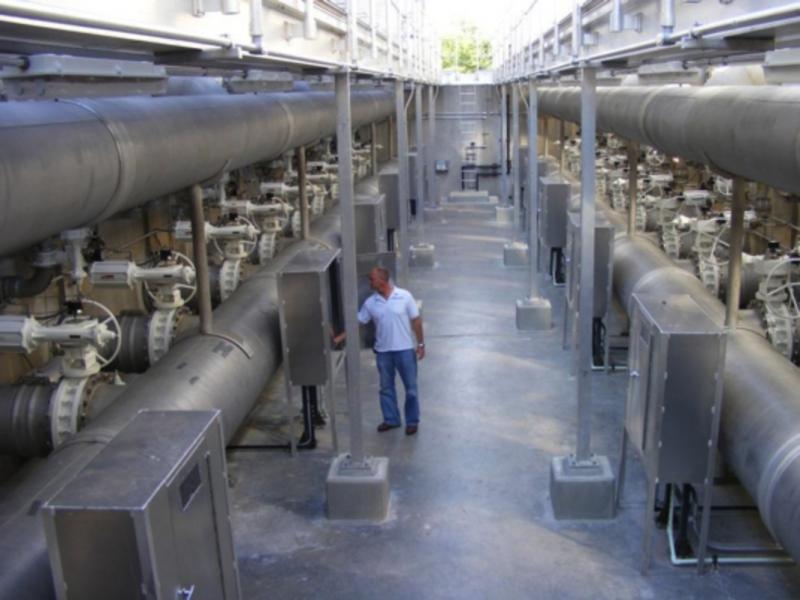Stressors and impacts
Nearly half a million people in southwest Florida rely on the Peace River Manasota Regional Water Supply Authority—more simply, the Authority—for their municipal and household water needs. As the Science and Technology Officer at this mid-sized utility, Kevin Morris fills a number of roles: he is responsible for engineering, construction, planning, budgeting, and scientific modeling, all with the goal of providing a reliable supply of safe drinking water into the future.
The Authority’s source of water is the Peace River, but this rainfall-dependent river has highly seasonal flows, forcing the Authority to rely on storage to meets its needs during dry weather. In order to have access to water when it is needed, the Authority uses two strategies to store water for later use:
- When water is abundant, they can divert water from the river to fill two off-stream raw-water storage reservoirs. Together, the two surface reservoirs can store nearly seven billion gallons of water.
- Available river water can also be pumped into an underground aquifer for storage, and then pumped out again when needed. This strategy is called "aquifer storage and recovery," or ASR. The Authority’s 21 ASR wells store water in a confined limestone aquifer between 500 and 1,100 feet below ground. The ASR system can store almost as much as the surface reservoirs, but it takes much longer to store and retrieve the water from the aquifer than from the surface reservoirs. Additionally, the water stored in the ASR wells has to be treated to drinking water standards first, so it is more costly from an operational standpoint.
Recognizing vulnerabilities
The Authority’s river intake pump station is located at sea level, so during very high tides, or in the dry season when the river has very low freshwater flow, brackish water can migrate upstream to the utility’s water intake. It is during these periods that the Authority relies upon its stored reserves. When these reserves are full, they are sufficient to meet customer demands for up to 10 months without replenishment.
Water stored in ASR wells mixes with native groundwater during storage, and when it is recovered it will have higher mineral content (higher hardness and sulfate levels). The longer ASR recovery continues, the more closely the recovered water will approximate native groundwater. Therefore, withdrawals from the ASR system and surface reservoirs have to be carefully managed to control water quality and also paced to match expected hydrologic conditions so that the combined reserves last until the wet season, when they can be replenished.
Finally, water from the Peace River is highly organic, resembling the color of dark tea. This limits light transmittance and therefore lessens the risk of algae growth in the reservoirs. However, water recovered from ASR wells is essentially clear, so as ASR recovery progresses, the water in the reservoirs becomes progressively lighter, leading to increased risk for algal blooms. The decision of when the utility should commence ASR recovery operations thus has wide-ranging ramifications beyond just having adequate reserves to meet the needs of its customers—it also affects operational costs, water quality, and reservoir maintenance/management.
Developing a decision-support index
Morris wanted to come up with an objective, reliable way to determine the best time to begin pumping water from the ASR wells. His choice to develop a new decision support tool was in large part influenced by his participation in a collaborative scientist-stakeholder network. This innovative partnership, the Florida Water and Climate Alliance, is supported by NOAA and facilitated by the University of Florida Water Institute. “The interdisciplinary group brought utility folks together with climate scientists, hydrologists, and social scientists to help us take a critical look at climate data and how we make decisions in our industry,” Morris said. “We began to realize we could improve our processes by developing decision science tools customized for the challenges we face. We also recognized our experience could be helpful for other utility managers seeking to navigate the broad spectrum of uncertainty in water supply decisions.”
Morris worked with others to blend measures of current water supply, hydrologic conditions, and monthly and seasonal outlooks for temperature and precipitation with scenarios depicting future water demand. The result was an index that will help the Authority decide when to initiate ASR recovery. Altogether, the ASR Recovery Initiation Index considers 10 different elements. Each variable is weighted to generate a daily index value, and the daily values are smoothed using a 30-day running average. If the resulting index value rises above 1.0, operators may decide to initiate ASR Recovery.
The ASR Recovery Initiation Index is a good example of how utilities can apply decision science linked with climate prediction products to make defensible, accurate water resource management decisions. Because the index can be calculated using common spreadsheet programs such as Excel, no specialized software or training is necessary. And as the variables in the index are common to many water supply efforts, it could be useful as a guide for other utilities wanting to devise an algorithm to guide their decision making for using multiple sources of water. This model, and the process followed to develop it, may be a useful example for utilities that don’t yet have a definitive framework for their water supply decisions.
Sanibel sun, own work. CC BY-SA 3.0, http://creativecommons.org/licenses/by-sa/3.0, via Wikimedia Commons.







